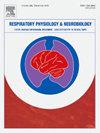Effects of threshold inspiratory muscle trainer versus trigger sensitivity adjustment versus conventional therapy on respiratory function in mechanically ventilated patients: a randomized controlled trial.
IF 1.6
4区 医学
Q3 PHYSIOLOGY
引用次数: 0
Abstract
Background
Prolonged mechanical ventilation in chronic obstructive pulmonary disease is associated with severe complications, and then earlier weaning is desirable. Then, strategies such as inspiratory muscle training (IMT) have been studied. This study aimed to compare the effects of IMT via Threshold device versus trigger sensitivity adjustment of the mechanical ventilator versus conventional therapy on respiratory parameters on chronic obstructive pulmonary disease weaning patients.
Methods
Ninety patients (aged 50–70) with acute respiratory failure on mechanical ventilation selected from the Intensive Care Unit were randomly assigned into: IMT via Threshold and conventional physical therapy group; trigger sensitivity adjustment of the mechanical ventilator and conventional physical therapy group; and conventional physical therapy alone group. Negative inspiratory force (NIF), respiratory rate (RR), tidal volume (VT), rapid shallow breathing index (RSBI), pH, and oxygenation parameters (PaO2, PaCO2, and P/F ratio) were measured pre and post-treatment.
Results
Threshold group showed higher improvements in NIF than the trigger sensitivity adjustment group (p = 0.002; ES: 0.91). Threshold group showed better results in all measures than conventional physical therapy group except for pH and PaCO2. Trigger sensitivity adjustment and conventional physical therapy groups showed significant improvements in all measurements (p < 0.005 for NIF (2.30), RR (1.69), VT (0.80); RSBI (2.09), PaO2 (1.20), P/F ratio (1.22) except for VT, pH, and PaCO2 with preference to trigger sensitivity adjustment group. No significant differences were found in the percentage of weaning between groups, but Threshold group showed significantly lower weaning days than conventional physical therapy group (p = 0.004, ES:1.01).
Conclusion
The respiratory training with the IMT device has significantly higher improvements than the other techniques and reduces the weaning duration.
阈值吸气肌训练器与触发敏感性调节与常规治疗对机械通气患者呼吸功能的影响:一项随机对照试验。
背景:慢性阻塞性肺疾病患者延长机械通气时间与严重并发症相关,因此需要尽早脱机。然后,研究了吸气肌训练(IMT)等策略。本研究旨在比较阈值装置IMT与机械呼吸机触发敏感性调节与常规治疗对慢性阻塞性肺疾病脱机患者呼吸参数的影响。方法选择重症监护病房收治的机械通气急性呼吸衰竭患者90例(50 ~ 70岁),随机分为阈值IMT组和常规物理治疗组;机械呼吸机与常规物理治疗组触发敏感性调整;常规物理治疗单独组。测定治疗前后的负吸气力(NIF)、呼吸频率(RR)、潮气量(VT)、快速浅呼吸指数(RSBI)、pH、氧合参数(PaO2、PaCO2、P/F比)。结果阈值组NIF改善程度高于触发敏感性调整组(p = 0.002;ES: 0.91)。除pH、PaCO2外,阈值组各项指标均优于常规理疗组。触发敏感性调整组和常规物理治疗组在所有测量指标上均有显著改善(p <; 0.005:NIF (2.30), RR (1.69), VT (0.80);除VT、pH、PaCO2外,RSBI(2.09)、PaO2(1.20)、P/F比(1.22)优先触发敏感性调节组。各组断奶率差异无统计学意义,但阈值组断奶天数明显低于常规物理治疗组(p = 0.004,ES:1.01)。结论使用IMT进行呼吸训练比其他方法改善效果明显,缩短了脱机时间。
本文章由计算机程序翻译,如有差异,请以英文原文为准。
求助全文
约1分钟内获得全文
求助全文
来源期刊
CiteScore
4.80
自引率
8.70%
发文量
104
审稿时长
54 days
期刊介绍:
Respiratory Physiology & Neurobiology (RESPNB) publishes original articles and invited reviews concerning physiology and pathophysiology of respiration in its broadest sense.
Although a special focus is on topics in neurobiology, high quality papers in respiratory molecular and cellular biology are also welcome, as are high-quality papers in traditional areas, such as:
-Mechanics of breathing-
Gas exchange and acid-base balance-
Respiration at rest and exercise-
Respiration in unusual conditions, like high or low pressure or changes of temperature, low ambient oxygen-
Embryonic and adult respiration-
Comparative respiratory physiology.
Papers on clinical aspects, original methods, as well as theoretical papers are also considered as long as they foster the understanding of respiratory physiology and pathophysiology.

 求助内容:
求助内容: 应助结果提醒方式:
应助结果提醒方式:


